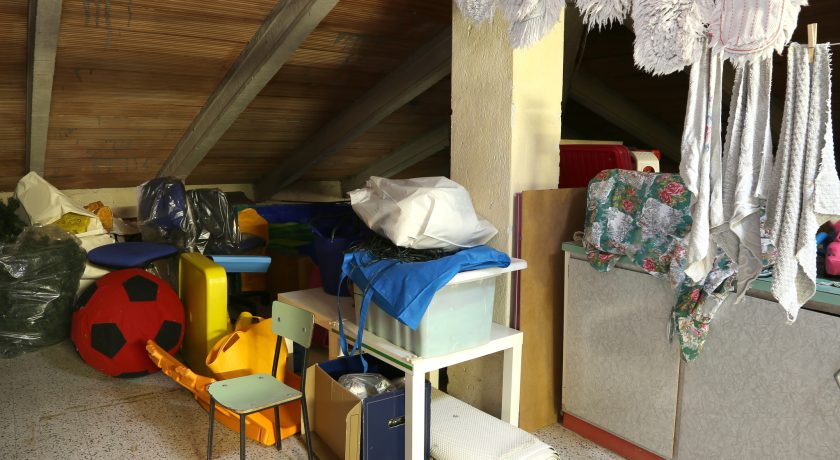Transform Your Attic into Storage with Ease

Are you looking for ways to maximize the storage or living space in your home? Look no further! If you have an attic in your home it can be the ultimate game-changer for your storage needs. Often overlooked, your attic space offers valuable footage that can be optimized for attic storage solutions.
At XYZ Storage, we understand cleaning and preparing your attic to turn it into attic storage space is no easy task, which is why we’ve created a guide to help you create a functional storage room. With proper planning, you can make the most of your floor space and attic ceiling height while protecting your belongings and maintaining easy access to them.
Preparing Your Attic for Storage
Before you start moving boxes into your attic, it’s essential to prepare the space properly. A well-prepared attic not only prevents damage to your belongings while in storage, but also makes them easily accessible. So let’s dive into how to turn your attic into storage space with these four key steps to ensuring your unfinished attic is ready for storage:
1. Safety First
The first step to take to transform your unfinished attic into a storage space or a usable living space is to assess if it can safely support the weight of what you plan on storing. Whether you plan on storing multiple 25-pound boxes, bulky furniture, or holiday decorations, it’s crucial to ensure the structural integrity of your attic is safe.
You can start by checking the floor joists to ensure they are strong enough. However, it’s best to check with a professional structural engineer to see if reinforcing the attic floor is something that needs to be done before you begin the storage process.
Additionally, check local building code requirements to ensure compliance with weight limits, ventilation, etc. If you plan to make any structural modifications, obtaining the right permits may be necessary. For example, if you need to install suitable flooring as oftentimes attic floors are unfinished.
2. Insulate and Ventilate the Attic
There’s a good chance that your attic is susceptible to temperature and humidity fluctuations, which is why proper attic insulation is important. Insulation is critical to protecting your belongings, especially sensitive or valuable ones from damage while in storage. You can think about adding insulation (i.e. spray foam) to the floor and ceilings to help prevent moisture buildup over time and thus minimize any mold and mildew from forming.
Proper ventilation that is up to building codes is important, so adding attic vents will allow for better airflow and reduce heat accumulation, which is key if you’re planning an attic storage conversion.
3. Install Suitable Flooring
Attic floors are often unfinished, which makes them unsafe for storage. The best materials for attic flooring include plywood that evenly distributes weight. If you plan on using the space beyond just for storage, you can consider carpeting as a more comfortable option.
4. Improve Accessibility
Do you have proper attic access? If you’re using a stepping stool or a chair to gain access into your attic you should consider installing a pull-down ladder or building a staircase for easy access, especially if you plan on going into your attic frequently. When installing an entryway into your attic make sure it’s sturdy, safe, and easy to use to prevent injury.
What Can You Store in an Attic?
Now that you’ve prepared your attic for storage, it’s time to take some time to decide what you can store in there. While an attic is a great place to free up space and keep your home from feeling cluttered, not all of your belongings are suited for the environment of your attic. This is because attics are often prone to temperature fluctuations and humidity, which can damage your belongings when stored over long periods.
Here’s a breakdown of what’s safe to store in your attic and what you should consider storing elsewhere, like a temperature-controlled storage unit to avoid damage to your belongings long-term:
Safe to Store:
- Seasonal decorations
- Suitcases and travel bags
- Camping gear
- Sports equipment
- Holiday decorations
- Books
- Clothing (stored in vacuum-sealed bags)
- Photo albums
Avoid Storing:
- Electronics
- Important documents
- Wooden furniture
- Food and perishable items
Protecting Stored Items from Temperature Fluctuations
Even if you’re storing attic-safe items, taking extra precautions can help keep them in condition. Here are some ways to protect your belongings from heat, cold, and humidity:
- Install Proper Insulation: Attic insulation keeps stored items safe from extreme temperatures.
- Use Moisture Absorbers: Place silica gel packets or moisture absorbers in storage bins to prevent humidity buildup.
- Ensure Proper Ventilation: Use attic vents or fans to regulate airflow and prevent excess heat from accumulating.
- Cover Stored Items: Protect sensitive items with breathable fabric covers to prevent dust accumulation.
If you invest in proper insulation and attic storage conversion improvements, you’ll be able to get away with storing your temperature-sensitive belongings in your attic. However, to be on the safe side, especially with belongings that hold a ton of sentimental and monetary value, a self-storage unit can be a better option.
Space-Saving Storage Solutions for an Attic
Once you’ve decided what you can store in your attic to help you make the most of the space, here are four attic storage ideas you can take into consideration when storing your belongings.
1. Utilize Vertical Storage
It’s important to make the most of the available space you have and that includes any vertical space, especially if you’re fortunate to have a ton of ceiling height. Use tall shelves or storage racks to store your belongings to help keep items off the floor and maximize your space. Ultimately, making it easier to access your belongings while keeping it all organized.
2. Use Clear Storage Bins
When storing your belongings consider using clear plastic storage bins instead of cardboard boxes. Plastic bins protect contents from dust, moisture, and pests while allowing you to see what’s inside at a glance. This way, you won’t be spending hours searching for your belongings and it can be easily accessible.
3. Label Everything
Another way to make your belongings easier to locate in the future is to label bins and boxes are key to keeping track of stored items. You can even group similar items to make retrieval easier in the future. For example, labeling one container “Christmas decorations,” so you know exactly where your Christmas decorations are when the holiday season comes around.
4. Install Hanging Storage
Does your attic have exposed beams? Take advantage of that extra space by installing hanging racks, hooks, or ceiling-mounted storage systems. These can be great for lighter items, such as holiday wreaths, sports equipment, foldable lawn chairs, etc.
FAQs
Many homeowners have questions about how to turn their attic into a storage space, which is why we’ve answered some of the most common questions to help guide you through this process.
What steps should I take to prepare my attic for storage?
To summarize the above, you want to take the time to Inspect the structure, ensure proper attic insulation, install sturdy flooring, and improve accessibility with a safe ladder or staircase.
Do I need to reinforce the attic floor before storing items?
Yes, in most cases, floor joists need reinforcement to handle additional weight safely. Consult a contractor if you’re unsure about the attic’s weight capacity, especially before you try to store any large or heavy items, like a couch.
What types of items are safe to store in an attic?
Many items can be stored in your attic safely, including seasonal decorations, luggages, books, clothing, camping gear, and sports equipment.
How can I make the attic more accessible for storage?
Making your attic easily accessible is key to using it effectively for storage. Consider installing a pull-down ladder or staircase for safe and easy access. You also may want to consider ensuring there is adequate lighting, such as LED fixtures to navigate your attic easier.
What are the best materials to use for attic flooring?
Not all materials are meant to withstand heavy loads for storage. Plywood or reinforced boards provide durability and even weight distribution that you’ll need for proper and safe attic storage.
Should I insulate the attic before using it for storage?
Yes, proper insulation helps regulate temperature and prevents damage to stored items.
How do I protect stored items from temperature fluctuations in the attic?
Temperature changes can damage sensitive items over time, so here are a few ways to protect your stored belongings, including using attic insulation, moisture absorbers, and proper ventilation to maintain stable conditions.
What are some space-saving storage solutions for an attic?
Vertical shelving, labeled bins, hanging storage, and clear walkways can help maximize attic space efficiently. By implementing some of these solutions, you can make the most of your attic storage while keeping your belongings organized and well-protected.
How XYZ Storage Can Help
If your attic isn’t the ideal storage space due to temperature fluctuations, accessibility issues, or lack of structural support, XYZ Storage has the perfect solution for you. Our residential storage units provide a secure and climate-controlled alternative for storing seasonal decorations, extra furniture, or anything else you can’t keep in your home.
With conveniently located storage facilities across Toronto and the GTA, including Downtown Toronto, Toronto Midtown, Toronto West, Etobicoke, and Scarborough, we make it easy to store and access your belongings whenever you need them.
Have questions about what you can store in your storage unit? Stop by any one of our storage facilities, and our team of storage experts will be more than happy to assist you. Happy storing!












